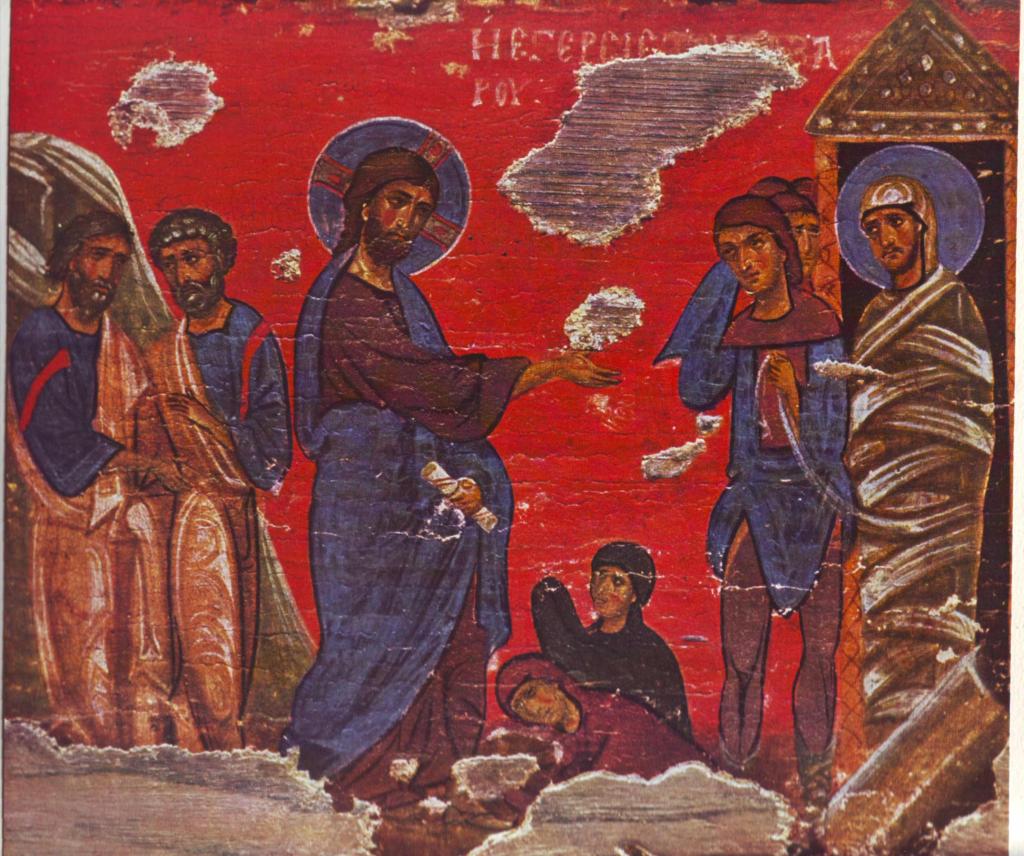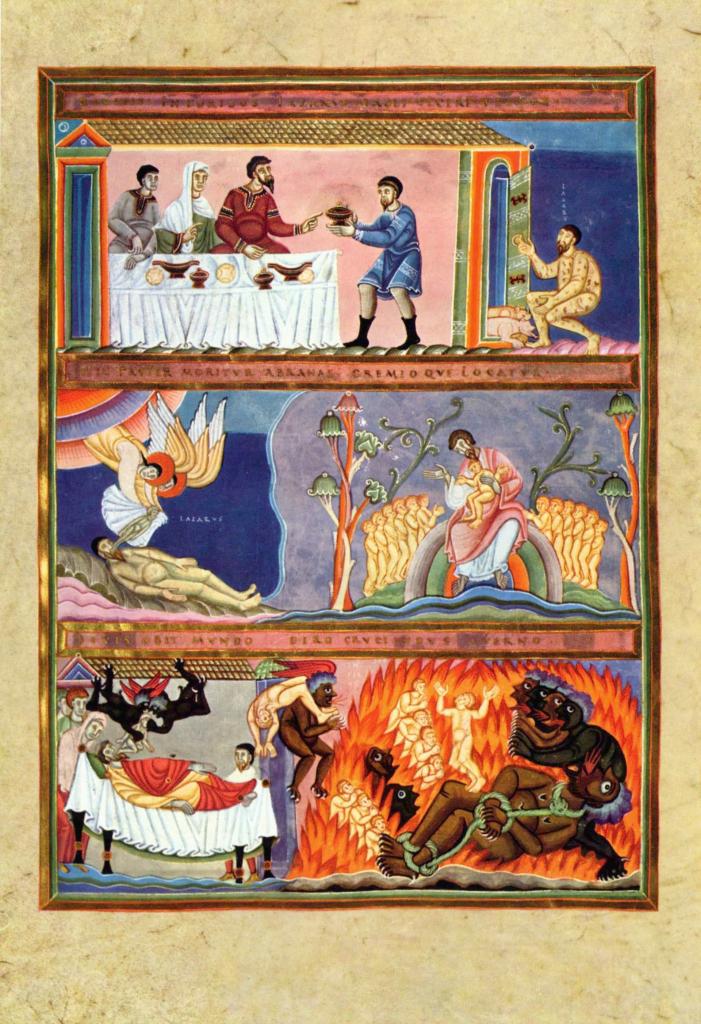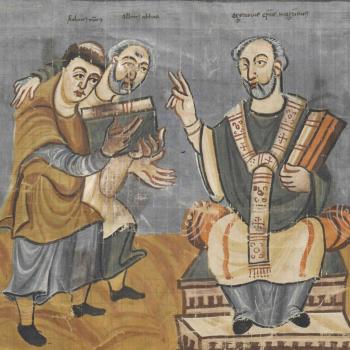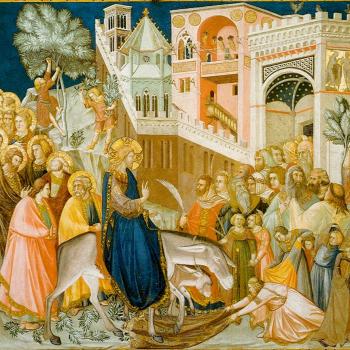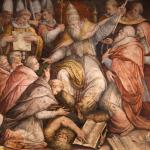Over the past couple of centuries, scholars have devoted a lot of attention to understanding story-telling. They examine how motifs emerge and evolve, and how they take different forms. Some are represented as historical fact, some as legend, and some in an inbetween category. Rarely does it do much good to try and seek the origins of such tales in solid history. Many have tried to apply such methods to Biblical texts and stories, with consequences that are controversial. In this post, I look at a story that appears in the New Testament, and (as I argue) manifests itself in several very different forms. I found that study quite revealing for understanding just how stories emerge and circulate, and how they end up in canonized scripture. It also told me a lot about how authors and editors work with the sources they find at hand.
My focus is on the story of Lazarus, which in the Gospel of John involves a spectacular miracle accomplished by Jesus. According to John’s gospel, Jesus raised Lazarus from the dead. But I will suggest that the same plot elements, and the same vocabulary, appear elsewhere in the New Testament, except that they manifest in totally different genres and settings. The obvious question is: which came first? What evolved into what?
I’ll offer three possibilities. A parable was repurposed as history. Or, a historical episode morphed into a parable. Or, and I will argue, most likely, both history and parable grew out of a homily or sermon – in fact, one of the very earliest Christian homilies of which we have record.
I
Lazarus: The Healing Miracle
Lazarus is best known from a passage that occurs in what is now John’s chapters 11-12, although the original readers knew nothing of any such divisions. It tells the story of a group of siblings who lived at Bethany, namely Mary, Martha, and Lazarus. The sisters know that Lazarus is ill, and they send to ask Jesus to help. He does come at their request, but arrives when Lazarus has been dead four days. However, he heals him, raising him from the dead. The miracle stirs the Jews to anger, provoking them to try and kill him. This is related to another theme, as Lazarus’s sister Mary anointed Jesus, and washed his feet with her hair. As I have discussed in earlier columns, John’s story has many similarities to versions in other gospels, but also differs substantially in detail.
Outside John, the foot-washing theme occurs only in Luke’s gospel, and that overlap is important in terms of what it suggests about sources. Scholars have recreated the sources of the four gospels, and one of these is usually called L. This represents material found in Luke’s gospel that are distinctive to Luke, and which do not derive from other sources such as Mark or the hypothetical Q. That does not mean that there ever existed a single book called “L”, as these Lukan materials were very diverse, and important. They include, for example, the major portions about the Virgin Mary, which supply most of what the Bible says about that figure. They also include several shorter passages that have odd and surprising connections with the Johannine tradition.
Nobody suggests that Luke sat down and invented those L materials himself: rather, they would have circulated independently as free-standing stories before they were attached to what became Luke’s gospel.
II
Lazarus: The Parable
Understanding that L source also points us to another story concerned with the name Lazarus, in a setting that at first glance seems totally unconnected.
John tells the well-known story of Lazarus as a straightforward narrative: Jesus did this, he says, and this happened, it was the ultimate miracle. But as many readers have pointed out through the centuries, there are curious resonances between this story and another tale which, as we have it, is presented not as a historical narrative but as a mysterious parable.
The name Lazarus occurs in just one other related setting in the New Testament, in a L passage found in Luke 16: 19-31. In this story, Lazarus is the name of a poor man despised by a rich neighbor. When they both die, Lazarus goes to eternal rest in Abraham’s bosom, while the rich man ends up in something like the later vision of Hell. Despite his pleading, the rich man cannot obtain help from Lazarus. Alarmed by his dreadful situation, the rich man wants to warn his relatives about the dreadful fate awaiting them, so they can repent. Couldn’t Abraham send Lazarus to warn them personally? No, says Abraham, “If they do not listen to Moses and the Prophets, they will not be convinced even if someone rises from the dead.”
Lazarus, in this story, is not depicted as an actual historical character, but he makes a curious figure in a parable. This is the only one of Jesus’s many parables in which a character is actually given a personal name, rather than being “a certain rich man,” “a leper,” or “a householder.” It is also the only parable in which one of the Old Testament patriarchs not only appears as a named character, but actually has a speaking part.
Although usually cited as a parable, it really is not. In terms of genre, the story’s closest relatives in literature are found in what we call the Old Testament Pseudepigrapha, or apocryphal literature, which proliferated between about 200 BC and 200 AD. These works offered fictional or legendary reworkings of Old Testament stories, usually focused on such major characters as Moses, Enoch or Isaiah, and even the surviving texts constitute a vast corpus. (A great many more have been lost through the centuries). Often, the stories used otherworldly or heavenly locations, and apocalyptic themes were common. The narratives made much use of angels, and the Luke story records how angels bore Lazarus’s soul to Abraham. Abraham was a very frequent character in the Old Testament Pseudepigrapha, and an Apocalypse of Abraham was composed probably in the late first century AD. Some scholars believe that in telling the story, Jesus was actually mocking or satirizing Pharisaic ideas about the afterlife, which were commonly expressed in such pseudepigrapha.
As an intellectual exercise, we might imagine what would have happened if the Lazarus parable had not been included in the gospels, but survived separately and was rediscovered in our own time. For multiple reasons, modern scholars would have no hesitation in categorizing it as a standard fragment of Old Testament Pseudepigrapha. Even given the reference to rising from the dead, there would be no obvious reason to assume a Christian context. (The classic modern discussion of the parable and its sources – Jewish, Egyptian, and other – is by Richard Bauckham, “The Rich Man and Lazarus: The Parable and the Parallels,” New Testament Studies, 37(2)(1991): 225-246)
III
Miracle and Parable
The resemblances between Luke’s Lazarus parable and the miracle story found in John are abundant. The Lazarus of the parable is after all a man who died, and the whole question is whether he will return from the dead, to take messages to the living.
As I noted earlier, L materials often recall John, and that is especially true in their treatment of Abraham. If you care to count, the name of Abraham occurs thirty times in the four gospels combined, including passing references in genealogies. The densest concentration of such references is a sequence of nine citations in John 8, all concerned with the question of defining who can legitimately claim to be Abraham’s children. That same question dominates Luke’s Lazarus passage, with its six Abraham mentions. Luke’s Lazarus lies in Abraham’s bosom, like a son with a loving father, while the rich man appeals to the mercy of “Father Abraham.” The fundamental question inspired by the story is deciding who is the true son of Abraham?
So what is the relationship between the Lazarus of John, and the figure in the “parable”? It is possible that Jesus on one occasion told a story about a poor man called Lazarus, and on another day, by remarkable coincidence, he actually raised a man of the same name from the dead. But other interpretations offer themselves.
i.History Has Become Parable
Perhaps Jesus told a story, which depended on his audience likely knowing the story of an earlier miracle in which a man of that name had been raised from the dead. The story would this be an unspoken but essential background to the parable. This would also explain why the parable as it stands is so sparse, and leaves so much unsaid.
Or else Jesus’s historical raising of Lazarus was well known in the early church, and writers used that as the basis for a not-quite-parable that they retroactively placed into Jesus’s mouth. The fact that it was drawn from an actual event with named characters accounts for the odd quality of the story. In either case, history has become parable.
As it stands, John’s Lazarus story raises many questions, but one surely must be why the event is not reported by any other gospel, or any other part of the New Testament, if indeed it occurred as reported. Unlike some other actions attributed to Jesus, this did not occur in a private setting, nor were those present sworn to secrecy. According to John, in fact, it created a public scandal, to the point of persuading the Pharisees that the Jesus phenomenon could not be restrained or ignored. John further implies that this sensitized Jesus’s enemies to the danger he posed, and prepared the way for the final confrontation in Jerusalem. Did the Synoptics really ignore such a tremendous and consequential historical event? Did Paul not know it to recall it in his epistles?
We just don’t know why a story unknown to other evangelists seems so critical to John, but conceivably this might reflect the often-noted geographical emphases of the different works. John, generally, is much more interested in affairs in Judea and Jerusalem, while the other evangelists are chiefly concerned with Galilee.
ii.Parable Has Become History
Another interpretation is that there was a story of a fictional man called Lazarus, which Jesus either composed or perhaps quoted, and that story is found in the L source. John knew that story, and transformed the fictional character into a real person whom he incorporated into his narrative.
John gave Lazarus a historical context as the brother of the two sisters Mary and Martha, who are otherwise only known in a L source, in Luke 10. (This is the story in which Mary listens to Jesus’s words, while Martha complains about doing the housework). Although all four gospels tell the story of Jesus’s anointing by a woman, only John associates that event with the named woman, Mary. By integrating the stories thus, John was able to combine two powerful stories of death and resurrection. As I have discussed, he did this partly by contrasting images of smell – by the stink from Lazarus’s tomb, and the glorious odor of the perfume that Mary used to anoint Jesus, even though she was doing this to forecast his own imminent death and burial.
John’s Bethany story therefore integrates at least three strands that otherwise are found only in L materials, although in Luke they have absolutely no connection with each other: these are the foot-washing episode, the role of Mary and Martha, and the Lazarus parable. The diversity of these materials, and the way in which they were available to be brought together into a single story, tells us a great deal about the form in which gospel stories circulated in the late first century, and how writers and editors could sew them together.
IV
Neither Parable Nor History
So was it a parable, or was it a miracle story? Actually, another altogether different possibility should be mentioned. Although Lazarus is mentioned nowhere else in the New Testament, many details of the story appear in a quite different setting and genre, in the Epistle of James.
James was for centuries something of an orphan in New Testament criticism, partly because Reformers like Luther took such a dim view of this Epistle. In recent decades, it has been treated much more seriously, and it is usually acknowledged that the text draws on some very early versions of Jesus’s sayings closely related to the Q tradition.
James 2. 1-10 is a homily or exhortation about the evils of treating people according to their apparent wealth and respectability, and showing prejudice against the poor. The passage overlaps closely and naturally with the Lazarus parable as we have it in Luke, and we see how similarly the passages are structured: the resemblances are far clearer in the Greek than in the English. I will use the KJV for convenience. Luke’s Lazarus story begins thus:
There was a certain rich man, which was clothed in purple and fine linen, and fared sumptuously every day: And there was a certain beggar named Lazarus, which was laid at his gate, full of sores, and desiring to be fed with the crumbs which fell from the rich man’s table: moreover the dogs came and licked his sores. (Luke 16.19-21)
And here is James:
For if there come unto your assembly a man with a gold ring, in goodly apparel, and there come in also a poor man in vile raiment, and ye have respect to him that weareth the gay clothing, and say unto him, Sit thou here in a good place; and say to the poor, Stand thou there, or sit here under my footstool. (James 2.2-3).
In both cases, the word used for the man in dire poverty is ptochos, which in its origins signifies one who cowers or crouches. In both, the words describing the poor man and his appearance are extreme, suggesting total degradation. In both, his poverty is stressed in relationship to his position beneath the rich man’s furniture – eating the crumbs that fell from his table, or sitting “under my footstool” (hypo to hypopodion mou). The Greek here suggests “beneath beneath feet,” that is, really flat on the floor.
In both James and the Lazarus passage too, the token of great wealth is the sumptuous garb of the rich, and related words occur in both descriptions. Luke’s rich man fares sumptuously (lampros); James’s rich man wears rich (lampra) apparel. That word suggests something like shining, brilliant, or radiant, and is a distant relative of the English word “lamp”: the Greek word lampas is usually translated in the gospels as lamp or torch. For what it is worth, lampros/lampra is not a common word in the New Testament. If you add cognate words, you find just eleven uses – four in Luke-Acts, two in James, and five in Revelation.
Lampra is commonly used in the context of angels or the righteous in heaven, and Luke likes the word. The mysterious angelic figure who appears to Cornelius in Acts 10.30 is in shining white (lampra) garments. In Acts 26, Paul reports the vision that converted him on the Road to Damascus, when he saw a light shining brighter (lamproteta) than the Sun. Hence, there is a degree of irony in the usage of both James and Luke: “You’re shining like the Blessed right now, but just you wait…”. Or even “Shine now, pay later.” In Revelation 18, the lamentation over fallen Babylon (ie a thinly disguised Rome) crows that all the city’s splendor (lampra) is gone forever.
A similar kind of irony occurs in Luke a few chapters after the Lazarus story. In Luke 23.11, the soldiers mock Jesus by dressing him in splendid (lampra) clothing, unintentionally signaling his heavenly status. It’s yet another example of the kind of verbal linkage that emerges so strongly in the Greek, but which is lost in even the best translations.
In their tales of rich and poor, both James and Luke proceed rapidly to the same point, which is that the poor, the ptochoi, will indeed inherit the kingdom. As James says,
Hearken, my beloved brethren, Hath not God chosen the poor of this world rich in faith, and heirs of the kingdom which he hath promised to them that love him? (2.5).
Some scholars think that this verse is a recollection or adaptation of a Jesus saying, a logion, which also appears in the Beatitudes – both in Matthew and Luke – as “Blessed are the poor [ptochoi].”
But to return to the question of form or genre, of whether and how the author of one story was recalling the other – and I am certainly not the first person to suggest a connection here. Luther himself drew obvious parallels between the Luke and James passages, although he did not suggest influence either way. He would have hated to say a good word for James.
The two stories, in James and Luke, might be wholly unrelated and independent. But assume that they are connected. Did an (odd) parable beget a homily, or vice versa? Is one closer to a story originally told by Jesus, or do both represent independent developments from an original message?
Has James has preserved an early version of a story in transition, in gestation, before the form that we see in the gospels?
Whatever we think, I am still baffled where the name Lazarus came from in all this.
V
So What Happened?
I offer a hypothesis, or a speculation. I suggest that an early Christian preached a homily on that logion, and he (or she) drew that stark contrast between rich and poor, with their subsequent fates in the afterlife. That story circulated in the early Christian world, and might even have evolved into a tale of the kind so often found in the Old Testament Pseudepigrapha. That in turn was represented as a parable told by Jesus himself.
And conceivably, John transformed the tale into an actual event, a miracle. He inserted a hitherto independent or free-floating tale of Lazarus into the pre-existing story of the two faithful sisters.
I make none of these statements with any confidence, but something like that sequence does seem to me the easiest way of explaining the various mysteries.
As you see, I offer lots of questions. But I think they are questions worth asking.


